This article is part of a series examining the role immigrants play in our labor force and the contributions they make to our economy.
Introduction
The United States has been a welcoming safe haven for refugees fleeing conflict and persecution since its founding in 1776. Over three million displaced people have relocated to the United States since 1975.[1] Refugee resettlement efforts peaked in 1980 when the country resettled over 200,000 refugees, most of whom were fleeing Communist Vietnam.[†]
Today, U.S. efforts to resettle refugees fulfill an important humanitarian mission while also providing significant economic benefits to the country. Refugees contribute billions of dollars each year to the economy through consumer spending and business start-ups, resulting in a net positive fiscal impact. Additionally, refugees help to revitalize declining areas and drive the creation of vibrant communities where Americans can proudly call home.
Annual refugee admissions to the United States, however, have fallen since 1980. Nonetheless, while the country continues to be the global leader in total numbers of refugees resettled, as a share of total population, other countries such as Canada and Australia admit far more refugees on a per capita basis.[2]
The global refugee population in 2016 was at a record 22.5 million people, according to a report from the United Nations High Commissioner for Refugees (UNHCR), while, at the same time, the Trump administration limited annual refugee admission for fiscal year (FY) 2018 at just 45,000.[3] Efforts to significantly curb or halt resettlement efforts on the basis of unfounded national security concerns would have serious consequences.[4] The current cap on refugee admissions not only diminishes the humanitarian impact of U.S. resettlement efforts, but also results in the loss of economic benefits that refugees provide. This article aims to provide an overview of research that demonstrates how refugees contribute to our nation’s well-being.
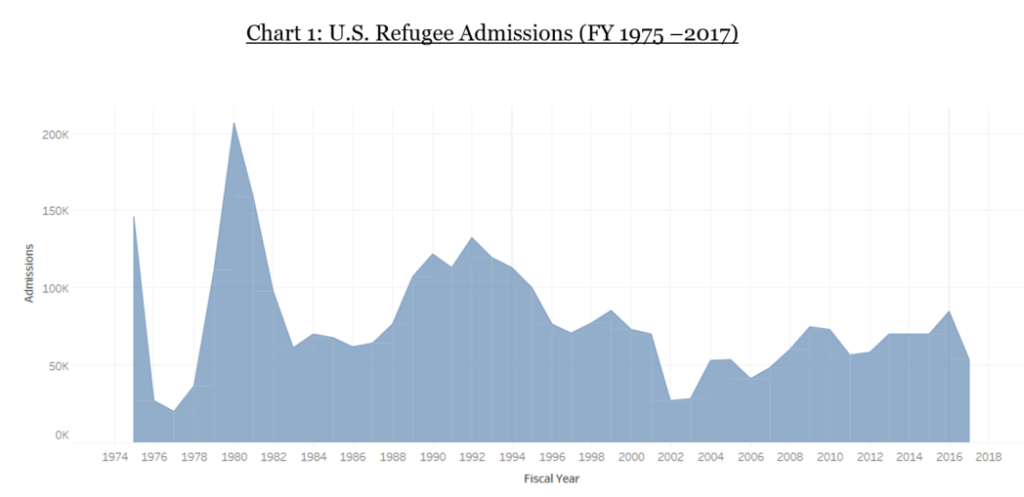
An Important Share of the American Workforce
Refugees are vital to the U.S. labor market by filling needed jobs, and, as a group, have a higher employment rate than the U.S.-born population. Male refugees of working age had a 67 percent employment rate from 2009 to 2011, while native-born males had only a 60 percent employment rate during the same time period. Refugee women were just as likely as native-born women to be employed.[5] The relatively high rate of employment among refugees is reflective of the labor market participation for the entire foreign-born population, who also work at a higher rate than does the native-born population.[6] Refugees are also more likely than the U.S.-born population and other immigrants, to be of working age (25-64 years).[7] The combination of refugees’ high employment rate and their substantive working age population signals that they are likely to be important contributors to their local economies.
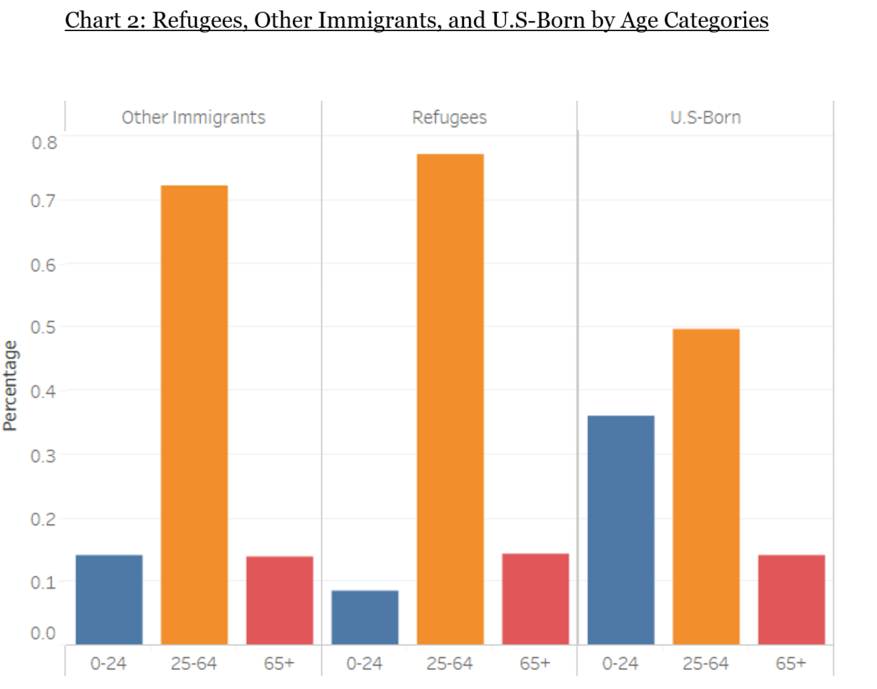
Refugees are employed in various industries including manufacturing (20.3 percent), health care (14.2 percent), and general services (10 percent), representing the top three fields.[8] Employed refugees do not remain in the same jobs more often than not, they move on to positions with higher earnings.

A study of Somali, Burmese, and Hmong refugees found* that, after living in the United States for at least ten years, these populations tended to move from primarily blue collar and service jobs to white collar positions. Nearly, a quarter of the Burmese in the study became executives, administrators, doctors, lawyers, and engineers. The study found that Burmese refugees had a higher percentage (24 percent) in professional capacities compared to U.S.-born employees (16 percent) while Somali, Burmese, and Hmong refugees tend to concentrate over time in teaching, social work, and the arts.[9] The shift into white collar work indicates that refugees not only make substantial investments in human capital, like education and English ability, but are also responsive to the changing labor demands of the economy.
Refugees recognize the advantages of investing in developing skills necessary for better employment opportunities and higher wages.
A study of refugees who arrived to the United States in 1980 found that ten years later these refugees earned 20 percent more than economic immigrants during the same time period.[10] The refugees also edged out economic immigrants by working four percent more hours and improving their English literacy skills 11 percent more. By 1990, the refugees saw their earnings grow 26 percent and their English-language abilities jump ten percent, relative to the 1980 baseline.[11] Refugees recognize the advantages of investing in developing skills necessary for better employment opportunities and higher wages. The refugees’ willingness to make those key investments in learning English and gaining more education makes them valuable economic contributors in their own right. Refugees realize economic benefits from their human capital investments over time, reflecting findings that other non-economic immigrants experience from their investments as well. Duleep and Regets (2017) compare the outcomes of family-based versus employment-based immigrants and find that family-based immigrants experience a higher earnings growth rate over time because they invest in developing new skills at high rates, similar to what refugees do.[12]
The impact of immigration on native employment has long been debated by the public, despite the academic consensus that immigration has a minor impact on the labor market. For example, the 1980 mass emigration of Cuban refugees to Florida, known as the Mariel Boatlift, has been examined to determine if there is such an impact. During the five-month boatlift, President Fidel Castro lifted travel restrictions and allowed about 125,000 Cubans to flee. Economist David Card’s 1990 landmark analysis of the Marielitos’ effect on the Miami area labor market has recently been reexamined and brought the issue back into the academic spotlight. Card found that the Marielitos had little to no impact on native Miami workers and that the Miami labor market was effectively able to accommodate the influx of people.[13] The leading immigration skeptic among economists, George Borjas (2017), argues that Card is wrong and that low-skilled Miami workers did experience wage decreases due to the massive influx of Cuban refugees.[14] In response, Clemens and Hunt (2017) and Peri and Yasenov (2017) find that Borjas’ conclusion was false and a result of a sampling and measurement error.[15] Maybal, et al. (2017) also adds to the consensus that refugees have little impact on native-born workers through an examination of U.S. refugee admissions from 1980 to 2010, finding no long-term adverse impact on the labor market.[16] Unfortunately, the volume of labor economics papers specific to refugee is limited. The research that does exist suggests that, the benefits of refugees — like the benefits of immigrants in general — significantly outweigh costs.
Entrepreneurs Driving the Economy and Creating Jobs
In addition to seeking employment, many refugees also opt to start their own businesses. Refugees, in fact, have higher entrepreneurship rates than the U.S.-born population and the foreign-born population. In 2015, over 181,000 refugee entrepreneurs generated $4.6 billion in business income.[17] These businesses provide jobs, goods, and services for thousands of Americans, both foreign and native-born. Refugees are entrepreneurial in sectors such as general services (26.1 percent), retail (11.2 percent), and transportation (10.7 percent).[18] The wide variety of areas in which refugee entrepreneurs operate demonstrates further the adaptability of refugees to the economic needs of where they live.

Furthermore, economists have identified that young businesses are primarily responsible for job creation, indicating that the entrepreneurial nature of refugees an even more valuable economic trait.[19] In fact, new businesses account for nearly all net new job creation, as well as 20 percent of gross job creation. Companies less than a year old have created an average of 1.5 million jobs per year over the last thirty years.[20]
In addition to the thousands of refugee-owned small businesses around the United States, several refugee-created businesses are among the most well-known companies in the U.S., including Google (Sergey Brin), WhatsApp (Jan Koum), and PayPal (Max Levchin).[21] The entrepreneurial spirit displayed by many refugees sends a clear signal about their willingness to work and contribute to their local economies.
Economic Engines for Local Economies
In 2015, refugees possessed $56.3 billion in disposable income that could be spent at businesses in their communities, making local economies stronger.[22] Refugees initially start out at low income levels, with a median annual household income around $22,000 during their first five years in the United States. However, in subsequent years, their income grows significantly. Annual median income reaches $37,000 after 15 years in the country. Refugee household income reach parity with median U.S. households after 25 years at $51,000. After 25 years, refugee households surpass median U.S. household income, earning $67,000 annually.[23] This growth in household income over time is reflective of the refugee community’s propensity to invest in human capital as well as the shift into white collar work observed for some refugee populations.
Median household income for refugees overall was $42,000 from 2009 to 2011. Refugee populations that have stayed the longest in the United States, such as the Vietnamese and Russian communities, have had much higher median incomes than more recent arrivals, like Somalis, Iraqis, and Bhutanese.[24] Discounting economic contributions to the country made by refugee communities, based solely on their initial low earning, ignores the full context of the refugee experience. The longer refugees stay in the United States, the more likely their spending power and incomes increase, benefitting economies in the long run.
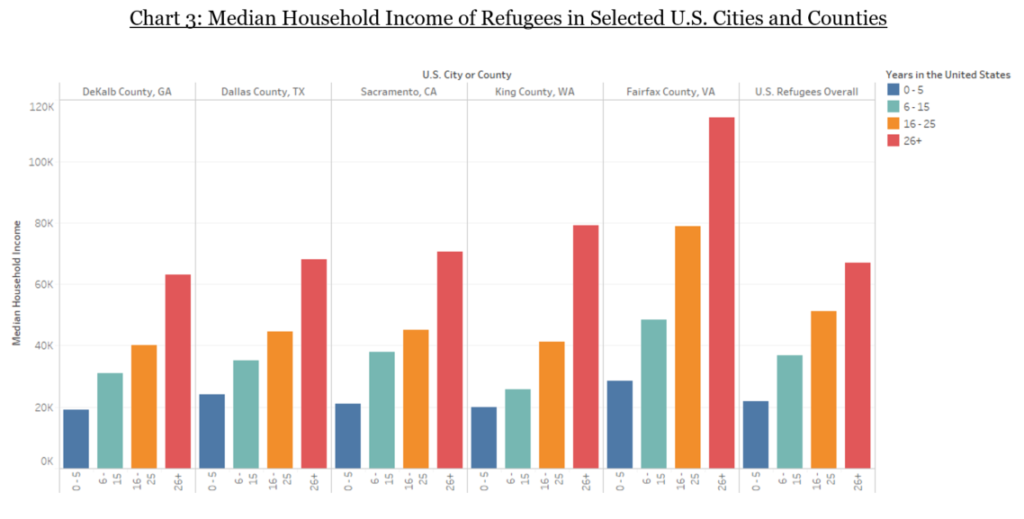
Purchasing a home, for example, is often considered a sign of economic health, and after a period of time, refugees have shown they have the capacity to own their own homes. Burmese and Bosnian refugees, who have resided in the United States for at least ten years, have higher home ownership rates, 73 and 72 percent respectively, than that of native-born Americans (68 percent).[25] Refugees also tend to own their homes at higher rates than other immigrants.[26]
Refugees have real impact when they move into areas that were previously in decline, helping to spark community growth. In “Rust Belt” cities and elsewhere, refugee resettlement offers a powerful mechanism to help prevent population decline and the spread of urban decay, as well as establish vibrant new communities. [27]
A Case Study on the State and Local Impacts of Refugees: The Midwest
When analyzing the impact of refugee resettlement, it is important to consider the local economic and fiscal implications, in addition to the national implications. Refugees are resettled throughout the United States, but the Midwest Ohio, Michigan, and Illinois have historically been among the leading states for refugee resettlement. Nearly 2,700 refugees resettled in the Midwest* from October 1, 2017 through January 31, 2018, accounting for about a third of all U.S. refugee admissions. Ohio, during the same time period, resettled 676 refugees, the most received by any state in the country.[28] Other Midwestern states, including Nebraska, North Dakota, South Dakota, and Minnesota, have high numbers of refugees resettled on a per capita basis.[29]
A number of analyses by researchers attest to the value of economic contributions by refugees in Midwestern communities. One study found that in Southeast Michigan, refugees were responsible in 2016 for $229.6 million to $295.3 million in economic activity and for creating 1,800 to 2,300 jobs. This includes refugee entrepreneurs, whose businesses generated $70 million to $90 million in economic benefits, along with 319 to 410 jobs.[30] Continued refugee resettlement can help spur economic growth and prevent economic stagnation[31] for Midwestern states with minimal population growth such as Michigan.
Continued refugee resettlement can help spur economic growth and prevent economic stagnation.
Refugee resettlement in Ohio, similar to Michigan, has been a major economic boon. In Franklin County, 13.6 percent of all working-age refugees are entrepreneurs, more than double the rate of native-born residents. An estimated 873 refugee-owned businesses in the Columbus area employ nearly 4,000 people, with the refugee community at-large supporting over 21,000 jobs.[32] These refugee-supported jobs accounted for approximately two percent of Columbus-area jobs in 2013.[33] Columbus-area refugees, however, had a higher unemployment rate than the native-born population, yet with a higher workforce participation rate. This signals that this group is less likely to give up on employment searches and exit the labor force. In 2013, Columbus-area refugees generated approximately $35.9 million in household spending, and $1.6 billion in overall economic activity.[34] Not only have the refugees benefited the Columbus metro area with jobs and consumer spending, but they have also had an economic impact throughout Ohio.
In 2013, refugees in Akron held $23 million in household spending power and paid over $3 million in state and local taxes. Akron refugees also contributed $3.6 million to Social Security and over $840,000 to Medicare. In addition, 86 percent of refugees were of working age, compared to just 66 percent of the U.S.-born population. Refugees made up 5.6 percent of manufacturing workers and 6.7 percent of city service workers, while accounting for just 1.3 percent of Akron’s total population. Over 11 percent of immigrants and refugees in the Akron area owned a business, and over 1,100 manufacturing jobs, 2.7 percent of total manufacturing jobs, have remained in the area because of the refugee population.[35]
Refugee household spending, refugee-owned businesses, and refugee-service organizations combined generated in 2012 650 jobs and $48 million in economic benefits in Cuyahoga County, which includes Cleveland. Cleveland-area refugees, their businesses, and support service organizations contributed $2.7 million to state and local taxes the same year. Cleveland refugees also tend to have higher earnings than their counterparts in other sections of the country and have a higher employment rate than the broader refugee population in the country. Also, one study found that public assistance use by refugees in Cleveland was lower than cities with refugee communities and declines rapidly over time.[36]
Refugees have done well elsewhere in the United States. From 1990 to 2012, refugees in Tennessee generated over $1.3 trillion in state revenue, while only accounting for $753 million in state expenditure, a net benefit of over $633 million.[37] In Georgia, 91 percent of refugee households were entirely self-sufficient and working within six months of arrival. Refugee services organizations contributed over $3 million to the Georgia economy in FY 2016.[38] In Erie, Pennsylvania, refugees have helped employers in manufacturing and other sectors remain in business, as well as open needed stores in areas with limited resources.[39]
Fiscal Contributors Helping to Solve Demographic Challenges
Refugees face a number of challenges when they resettle: they must build a new life, in a new country and do so with limited resources. In addition, they may continue to address effects of trauma associated with fleeing their homeland due to conflict or persecution. Refugees are provided with various services upon arrival to help them adjust to life in the United States and to set them on a path to self-sufficiency. Resettlement organizations typically receive refugees when they first arrive, as well as provide housing, clothing, food, and community/cultural orientation. They also assist refugees in finding employment, health care, legal services, and English instruction.[40] Providing essential services to refugees when they arrive and transition to living in the U.S., helps to ensure that they will successfully integrate into American society and thrive as new Americans.
At first, refugees may initially receive more services than they pay in taxes. Resettlement organizations provide initial services to set the stage for the refugees’ long-term success and, over time, they end up paying more in taxes than they receive in benefits. Refugees between the ages of 18 and 45 pay an estimated $21,000 more in taxes than they receive in benefits over a 20-year period.[41] For example, refugees participate in food stamp programs initially, but, over time, their usage drops off considerably.[42]
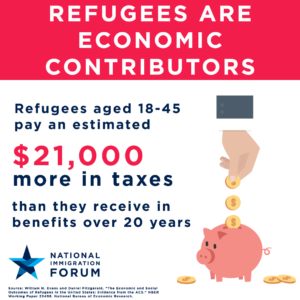
A Department of Health and Human Services (HHS) report, leaked in September 2017, found that refugees were net fiscal contributors, at $63 billion between 2005 and 2014.[43] Specifically, refugees contributed almost $41 billion in net fiscal benefits to the federal government and $22 billion to state and local governments. Refugees and their non-refugee children were net benefits to the federal government at nearly $53 billion during the same time period. Their net costs to state and local government were $35.9 billion, largely due to education costs.[44] But, second-generation Americans, including the children of refugees, have, on average, higher levels of income, education, and home ownership. They also have lower poverty rates than their parents.[45]
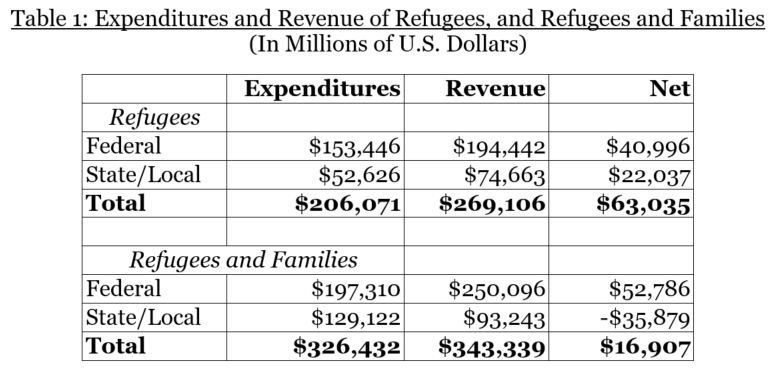
As net fiscal contributors, refugees can help America overcome demographic challenges brought on by an aging population. As the country’s population ages, more seniors depend on fewer and fewer working age people to keep the Social Security Trust Fund solvent. Increasing the number of refugees resettled in the United States increases the number of working people paying federal taxes, who are not drawing from Social Security, thereby extending the solvency of the Trust Fund.[46] The same holds true for funding for other programs, such as Medicare. Immigrants contributed $182.4 billion more to the Medicare Hospital Insurance Trust Fund from 1996 to 2011 than they received in benefits.[47] As refugees’ income rises over time, their payments into the system will also increase and extend the solvency of the programs. Refugees and their children can help slow the aging of the U.S. workforce.
Conclusion
As the research discussed in this paper shows, refugees contribute to building our economy and our nation. Refugees are an incredibly valuable economic and fiscal resource. They work hard, start their own businesses, spend money in local economies, and help revitalize struggling communities. Over time, refugees also prove to be overwhelming positive fiscal contributors, helping to extend the solvency of important programs like Social Security and Medicare while countering the aging of the U.S. workforce. At a time when global demand for refugee resettlement is at a record level, a drastic cut in refugee admissions represents a missed opportunity for the U.S. Such cuts would not only be an abdication of a moral responsibility the U.S. has upheld for decades, but a serious economic and fiscal blunder.
The National Immigration Forum would like to thank Jeff Mason, former policy intern and primary author, for his extensive contributions.
To see all papers in the Immigrants as Economic Contributors series, click here.
[†] This does not include the Cubans who immigrated to the U.S during what is known as the “Mariel Boatlift” as they were not given refugee status in 1980.
* The study examined also trends among Bosnian refugees, who did not experience such career advancement.
*”Midwest” includes Illinois, Indiana, Iowa, Kansas, Michigan, Minnesota, Missouri, Nebraska, North Dakota, Ohio, South Dakota, and Wisconsin.
[1] Jens Manuel Krogstad and Jynnah Radford. “Key facts about refugees to the U.S.” Pew Research Center. January 30, 2017. Available at: http://www.pewresearch.org/fact-tank/2017/01/30/key-facts-about-refugees-to-the-u-s/.
[2] Susan Fratzke. “In Wake of Cuts to U.S. Refugee Program, Global Resettlement Falls Short.” Migration Policy Institute. December 13, 2017. Available at: https://www.migrationpolicy.org/article/top-10-2017-issue-6-wake-cuts-us-refugee-program-global-resettlement-falls-short.
[3] UNHCR. “Global Trends: Forced Displacement In 2016.” June 19, 2017. Available at: http://www.unhcr.org/5943e8a34.pdf; Joel Rose. “Trump Administration To Drop Refugee Cap To 45,000, Lowest In Years.” NPR. September 27, 2017. Available at: https://www.npr.org/2017/09/27/554046980/trump-administration-to-drop-refugee-cap-to-45-000-lowest-in-years.
[4] Alex Nowrasteh. “Terrorism and Immigration: A Risk Analysis.” Cato Institute. September 13, 2016. Available at: https://www.cato.org/publications/policy-analysis/terrorism-immigration-risk-analysis.
[5] Randy Capps, et al. “The Integration Outcomes of U.S. Refugees: Successes and Challenges.” Migration Policy Institute. June 2015. Available at: https://www.migrationpolicy.org/research/integration-outcomes-us-refugees-successes-and-challenges.
[6] U.S. Bureau of Labor Statistics, “Foreign-Born Workers: Labor Force Characteristics — 2016.” May 18, 2017. Available at: https://www.bls.gov/news.release/pdf/forbrn.pdf.
[7] New American Economy. “From Struggle to Resilience: The Economic Impact of Refugees in America.” June 2017. Available at: http://research.newamericaneconomy.org/wp-content/uploads/sites/2/2017/11/NAE_Refugees_V6.pdf.
[8] Ibid.
[9] David Dyssegaard Kallick and Silva Mathema. “Refugee Integration in the United States.” Center for American Progress and Fiscal Policy Institute. June 2016. Available at: https://cdn.americanprogress.org/wp-content/uploads/2016/06/15112912/refugeeintegration.pdf.
[10] Cortes (2004) defines an economic immigrant as an individual searching for a better job and economic security. In contrast to refugee immigrants, economic immigrants are free from fear of persecution and may safely return to their home country at any time.
[11] Kalena E. Cortes. “Are Refugees Different from Economic Immigrants? Some Empirical Evidence on the Heterogeneity of Immigrant Groups in the United States.” IZA Discussion Paper No. 1063. Institute for the Study of Labor. March 2004. Available at: http://ftp.iza.org/dp1063.pdf.
[12] Harriet Duleep and Mark Regets. “Family-friendly and human-capital-based immigration policy.” IZA World of Labor. October 2017. Available at: https://wol.iza.org/uploads/articles/389/pdfs/family-friendly-and-human-capital-based-immigration-policy.pdf?v=1.
[13] David Card. “The Impact of the Mariel Boatlift on the Miami Labor Market.” Industrial and Labor Relations Review, Vol. 43, No. 2. January 1990. Available at: http://davidcard.berkeley.edu/papers/mariel-impact.pdf.
[14] George J. Borjas. “The Wage Impact of the Marielitos: A Reappraisal.” NBER Working Paper 21588. National Bureau of Economic Research. June 2016. Available at: https://sites.hks.harvard.edu/fs/gborjas/publications/journal/ILRR2017.pdf.
[15] Michael Clemens and Jennifer Hunt. “The Labor Market Effects of Refugee Waves: Reconciling Conflicting Results.” Working Paper 455. Center for Global Development. July 2017. Available at: https://www.cgdev.org/sites/default/files/labor-market-effects-refugee-waves-reconciling-conflicting-results-July-revision.pdf.pdf; Giovanni Peri and Vasil Yasenov. “The Labor Market Effects of a Refugee Wave: Applying the Synthetic Control Method to the Mariel Boatlift.” NBER Working Paper 21801. National Bureau of Economic Research. Available at: http://www.nber.org/papers/w21801.pdf.
[16] Anna Maria Mayda, et al. “The Labor Market Impact of Refugees: Evidence from the U.S. Resettlement Program.” Working Paper 2017-04. U.S. Department of State, Office of the Chief Economist. August 2017. Available at: https://www.state.gov/documents/organization/273699.pdf.
[17] New American Economy. “From Struggle to Resilience: The Economic Impact of Refugees in America.”
[18] Ibid.
[19] John C. Haltiwanger, Ron S. Jarmin, and Javier Miranda. “Who Creates Jobs? Small vs. Large vs. Young.” NBER Working Paper 16300. National Bureau of Economic Research. August 2010. Available at: http://www.nber.org/papers/w16300.pdf.
[20] Jason Wiens and Chris Jackson. “The Importance of Young Firms for Economic Growth.” Ewin Marion Kauffman Foundation. September 13, 2015. Available at: https://www.kauffman.org/what-we-do/resources/entrepreneurship-policy-digest/the-importance-of-young-firms-for-economic-growth.
[21] Phillippe Legrain. “Refugees Are a Great Investment.” Foreign Policy. February 3, 2017. Available at: http://foreignpolicy.com/2017/02/03/refugees-are-a-great-investment/.
[22] New American Economy. “From Struggle to Resilience: The Economic Impact of Refugees in America.”
[23] Ibid.
[24] Randy Capps, et al. “The Integration Outcomes of U.S. Refugees: Successes and Challenges.”
[25] David Dyssegaard Kallick and Silva Mathema. “Refugee Integration in the United States.”
[26] New American Economy. “From Struggle to Resilience: The Economic Impact of Refugees in America.”
[27] Matthew La Corte. “Refugees Are Revitalizing Some Great American Cities Facing Decline.” Niskanen Center. June 21, 2016. Available at: https://niskanencenter.org/blog/refugees-revitalizing-great-american-cities-facing-decline/.
[28] National Immigration Forum analysis of State Department WRAPS data. Available at: http://www.wrapsnet.org/admissions-and-arrivals/.
[29] Jynnah Radford and Phillip Connor. “Just 10 states resettled more than half of recent refugees to U.S.” December 6, 2016. Available at: http://www.pewresearch.org/fact-tank/2016/12/06/just-10-states-resettled-more-than-half-of-recent-refugees-to-u-s/.
[30] Elisabeth Gerber, Jacqueline Mullen, and Steve Tobocman. “Economic Impact of Refugees in Southeast Michigan.” Global Detroit. October 2017. Available at: http://www.globaldetroit.com/wp-content/uploads/2017/10/Final-Report-GLOBAL_DETROIT_FOR_PRINT_CMYK_10am.compressed.pdf.
[31] U.S. Census Bureau. “Annual Estimates of the Michigan Resident Population: April 1, 2010 to July 1, 2017.” Accessed using American FactFinder. Available at: https://factfinder.census.gov/bkmk/table/1.0/en/PEP/2017/PEPANNRES/0400000US26.
[32] Lynette Cook, et al. “Impact of Refugees in Central Ohio: 2015 Report.” US Together, Community Refugee & Immigration Services, World Relief Columbus, and the City of Columbus. Available at: http://ustogether.us/wp-content/uploads/2016/12/IMPACT-OF-REFUGEES-ON-CENTRAL-OHIO_2015SP.pdf.
[33]National Immigration Forum calculation using U.S. Bureau of Labor Statistics data. Data available at: https://data.bls.gov/timeseries/LAUMT391814000000005?amp%253bdata_tool=XGtable&output_view=data&include_graphs=true.
[34] Lynette Cook, et al. “Impact of Refugees in Central Ohio: 2015 Report.”
[35] Partnership for a New American Economy and the Knight Foundation. “Welcome to Akron: How Immigrants and Refugees are Contributing to Akron’s Economic Growth.” June 30, 2016. Available at: http://research.newamericaneconomy.org/report/welcome-to-akron/; National Immigration Forum calculation using U.S. Bureau of Labor Statistics data. Data available at: https://data.bls.gov/timeseries/SMU39104203000000001?amp%253bdata_tool=XGtable&output_view=data&include_graphs=true.
[36] Chmura Economics & Analytics. “Economic Impact of Refugees in the Cleveland Area: Calendar Year 2012.” October 2013. Available at: https://www.hias.org/sites/default/files/clevelandrefugeeeconomic-impact.pdf.
[37] Krista Lee. “A Study on the Federal Cost Shifting to the State of Tennessee As a Result of the Federal Refugee Resettlement Program For the Period 1990 through 2012.” Fiscal Review Committee, Tennessee General Assembly. November 12, 2013. Available at: http://www.hias.org/sites/default/files/tn_report_federalcostshifting_refugeeresettlement.pdf.
[38] Coalition of Refugee Service Agencies. “Refugees and Immigrants in Georgia: The Facts.” February 2017. Available at: https://crsageorgia.files.wordpress.com/2017/02/fact-sheet-2017-002.pdf.
[39] Miriam Jordan. “The Town That Can’t Do Without Refugees.” The Wall Street Journal. February 28, 2017. Available at: https://www.wsj.com/articles/the-town-that-cant-do-without-refugees-1488290400.
[40] U.S. Committee for Refugees and Immigrants. “Services.” Available at: http://refugees.org/serving-the-uprooted/services/.
[41] William N. Evans and Daniel Fitzgerald. “The Economic and Social Outcomes of Refugees in the United States: Evidence from the ACS.” NBER Working Paper 23498. National Bureau of Economic Research. June 2017. Available at: http://www.nber.org/papers/w23498.
[42] Christopher R. Bollinger and Paul Hagstrom. “Food Stamp Program Participation of Refugees and Immigrants.” UKCPR Discussion Paper Series #2003-05. UK Center for Poverty Research. June 2004. Available at: https://uknowledge.uky.edu/cgi/viewcontent.cgi?article=1095&context=ukcpr_papers.
[43] Julie Hirschfeld Davis and Somini Sengupta. “Trump Administration Rejects Study Showing Positive Impact of Refugees.” New York Times. September 18, 2017. Available at: https://www.nytimes.com/2017/09/18/us/politics/refugees-revenue-cost-report-trump.html.
[44] U.S. Department of Health and Human Services. “The Fiscal Costs of the U.S. Refugee Admissions Program at the Federal, State, and Local Levels, from 2005-2014.” July 29, 2017. Available at: https://www.nytimes.com/interactive/2017/09/19/us/politics/document-Refugee-Report.html.
[45] Paul Taylor, et al. “Second-Generation Americans: A Portrait of the Adult Children of Immigrants.” February 7, 2013. Available at: http://www.pewsocialtrends.org/files/2013/02/FINAL_immigrant_generations_report_2-7-13.pdf.
[46] Kenneth Megan and Theresa Cardinal Brown. “America’s Demographic Challenge: Understanding the Role of Immigration.” Bipartisan Policy Center. August 2017. Available at: https://bipartisanpolicy.org/wp-content/uploads/2017/08/BPC-Immigration-Americas-Demographic-Challenge.pdf.
[47] Leah Zallman. “Staying Covered: How Immigrants Have Prolonged the Solvency of One of Medicare’s Key Trust Funds and Subsidized Care for U.S. Seniors.” New American Economy. August 2014. Available at: http://research.newamericaneconomy.org/wp-content/uploads/2014/08/pnae-medicare-report-august2014.pdf.



